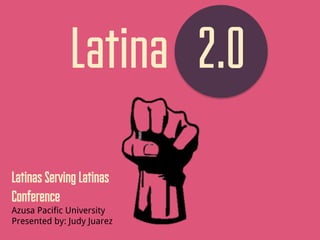Latina Identity 2.0
- 1. Latinas Serving Latinas Conference Azusa Pacific University Presented by: Judy Juarez Latina 2.0
- 2. What is identity? The condition of being oneself or itself, and not another
- 3. How is identity formed? Family Race/ CultureGender Religion Economic Status
- 5. Facing the Facts: In November 2013, the American Progress Report released a report outlining several facts about Latinaâs in the U.S., this is what they foundâĶ (American Progress Report, 2013)
- 6. The Latina share of the female population in the United States will increase from 16.4 percent today to 25.7 percent in 2050. Facing the Facts: Health
- 7. Latina teens experienced historic lows for teen pregnancy in 2012, at 39 percent. Facing the Facts: Health
- 8. Latina women experience unintended pregnancy at twice the rate experienced by white women. Facing the Facts: Health
- 9. Latinas are 17 times more likely to die from diabetes than non- Hispanic white women. Latinas also have higher rates of gestational diabetes, which puts them at greater risk for type 2 diabetes later in life. Facing the Facts: Health
- 10. The level of educational attainment for Latinas has risen in the past few years, yet it still sits at a level significantly lower than that of white women Facing the Facts: Education
- 11. College graduation rates for Latinas have increased faster than any other group of women. Facing the Facts: Education
- 12. Graduation rates for Latinas were at 31.3% in 2008, still significantly lower than graduation rates for white women, at 45.8%. Facing the Facts: Education
- 13. Only 3 percent of Latina women are represented in science, technology, engineering, and mathematics, or STEM, fields, while women in total make up 24 percent of the STEM workforce. Facing the Facts: Education
- 14. Latina women make 55 cents to the dollar when compared to white, non-Hispanic males. In comparison, white women make 78.1 cents to the same dollar. Facing the Facts: Entrepreneurship
- 15. Latina women make 88 percent of their male counterpartsâ annual full-time earnings. Facing the Facts: Entrepreneurship
- 16. 32.2 percent of Latina women work in the service sector, compared with only 20 percent of white women, and service workers are almost 20 percent less likely to have either paid sick leave or retirement benefits. Facing the Facts: Entrepreneurship
- 17. In Latina households, about 4 in 10 working wives were the primary breadwinners for their families, according to a 2010 CAP report. This doubles the rate from 1975. Facing the Facts: Entrepreneurship
- 18. Today, only 9 of the 98 women in Congress are Latina; all serve in the House of Representatives. Five of those nine women represent California. Facing the Facts: Political Leadership
- 19. From 1996 to 2010, the number of Latina elected officials increased by 105 percent. Facing the Facts: Political Leadership
- 20. What does the media say?
- 21. Now What? You get to define what Latina means Break the stereotypes Know your history
- 22. You Define You























